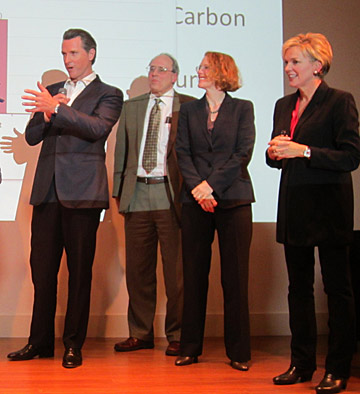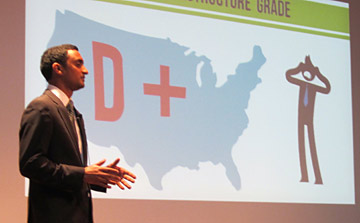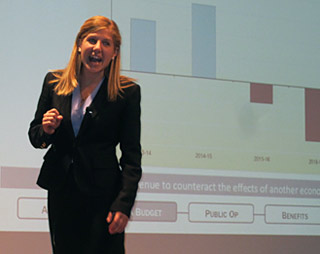By Andrew Cohen

of Public
Policy Dean Henry Brady, Berkeley Law
Dean Gillian Lester, and former Michigan
Gov. Jennifer Granholm.
Those who complain that Millennials are indifferent to the problems facing society would have been pleasantly surprised by what unfolded November 25 at UC Berkeley’s Banatao Auditorium.
Competing in “America’s Next Top Policy Model,” spirited teams of law and public policy students pitched wide-ranging proposals to a rapt audience and three high-profile judges: California Lt. Governor Gavin Newsom, Berkeley Law Dean Gillian Lester, and Goldman School of Public Policy Dean Henry Brady. Former Michigan Gov. Jennifer Granholm, the students’ instructor in a course called Governing During Tough Times, emceed the event.
One student from each of the eight final teams made four-minute pitches augmented by multi-media presentations. After each presentation, the judges took a few minutes to offer critiques, ask questions, and further probe the policy ideas. Audience members voted electronically for their favorite proposals in two heats of four groups each, and then chose between the heat winners.
“It was a great opportunity to think creatively in terms of political realities and public policy solutions,” said Berkeley Law student Shyaam Subramanian ’14. “Given the prevalent political gridlock and tight budgets, it’s important to think about what can be done and about what other places are doing successfully.”
Roads to recovery
The proposals targeted pressing issues such as prison recidivism, online voting, and business recruitment. Subramanian’s presentation on incentivizing public-private partnerships to improve America’s woeful infrastructure won its heat, drew Newsom’s highest praise, and placed just behind a carbon tax proposal in the final audience vote.

the United
States’ woeful infrastructure grade
from the American Society of Civil
Engineers.
“That was an outstanding presentation and I wouldn’t want to run against you for Lieutenant Governor,” Newsom told Subramanian. “To speak without notes precisely to the timing of the multi-media presentation behind you, I was impressed as hell by that. Your ability to globalize and localize the problem was exceptional.”
The proposal called for local infrastructure trusts—acting as a nonprofit, quasigovernmental entity—to serve as a liaison between public agencies that want a project completed and private investors willing to finance it. Cities could specify that the trust negotiate contracts, provide incentives, and coordinate with other experts on water, seismic, energy, and related issues.
Subramanian highlighted statistics showing that public-private infrastructure projects are completed 14 percent faster and 15 percent cheaper than when governments finish them on their own. He also cited a template for the policy that has made 75 buildings in Chicago more energy-efficient.
Policy prescriptions
Sophia Goren ’15 and Jamie Yood ’14 each finished a close second in their heats; other Berkeley Law presenters included Colin Allred ’14 and Aly Eber ’14 (online voting) and Nick Brokaw ’15 (prison recidivism).

legalizing and
taxing marijuana.
Goren’s proposal—“Taking California Higher”—noted the revenue, savings, and job creation benefits of legalizing marijuana. “Money doesn’t grow on trees, but it does grow on plants,” she said to raucous laughter. “This is a multi-million dollar cash crop and we need to tax it like alcohol or tobacco.”
Lester said Goren “didn’t appeal to personal freedoms, but instead played to a centrist theme of fiscal stabilization. That’s an effective, counter-intuitive way to come at the problem.”
Yood advocated for cities creating college funds for newborns with a modest donation and then providing incentives for families to add to them over time. “Research shows that kids with college savings accounts are seven times more likely to attend college,” Yood said. “We’ve seen similar programs work in liberal San Francisco and conservative Cuyahoga County, Ohio.”
“I learned about this from Hillary Clinton,” said Newsom, the former San Francisco mayor. “She stole it from England, I stole it from her, and you stole it from me. Well done!” Lester said she was “a big fan” of Yood’s policy idea and added, “I’m very much persuaded.”
At the end of the night, Lester thanked Granholm for coordinating the event and cited it as an instructive example of campus collaboration. “I love that this was something our law school and public policy school created together,” she said. “It led to an extraordinary night, something better than each of us could do individually. It shows what can happen when you form these kinds of partnerships.”